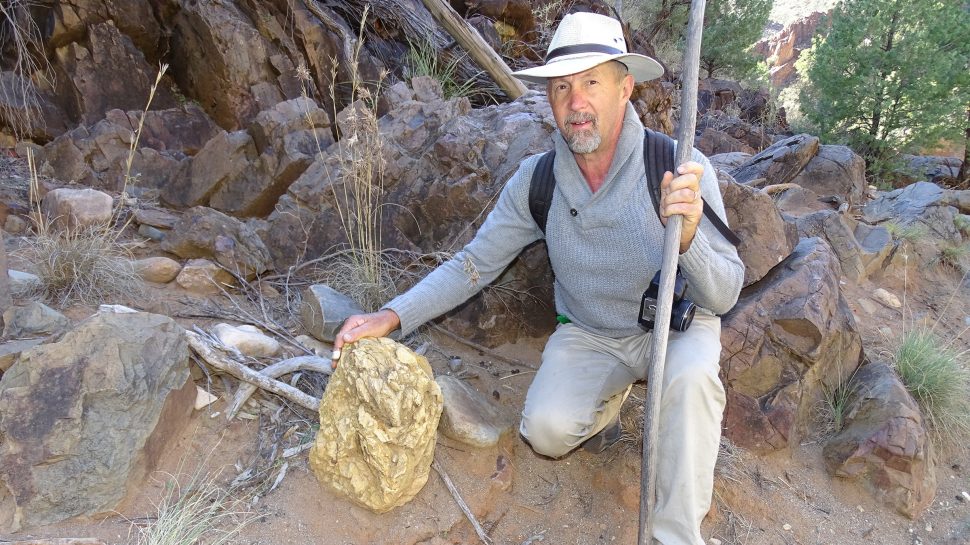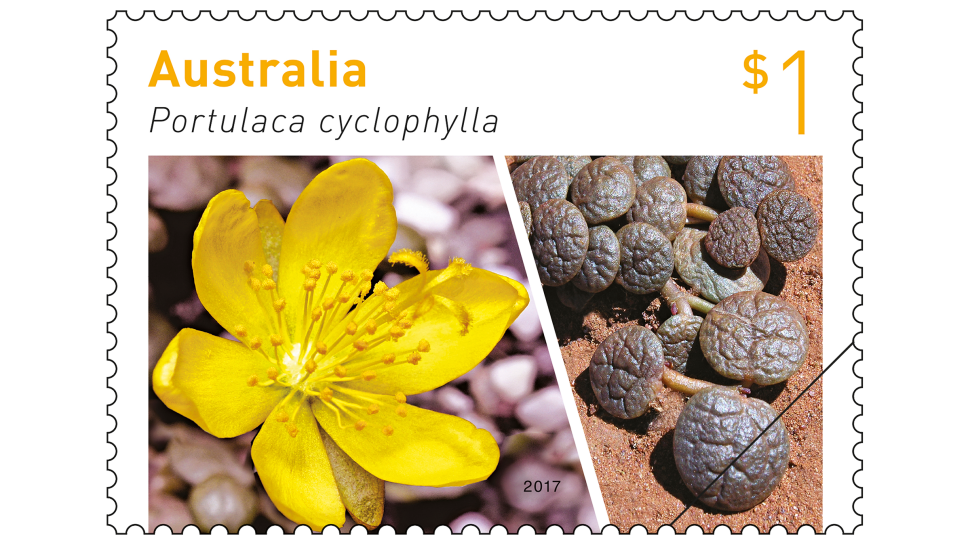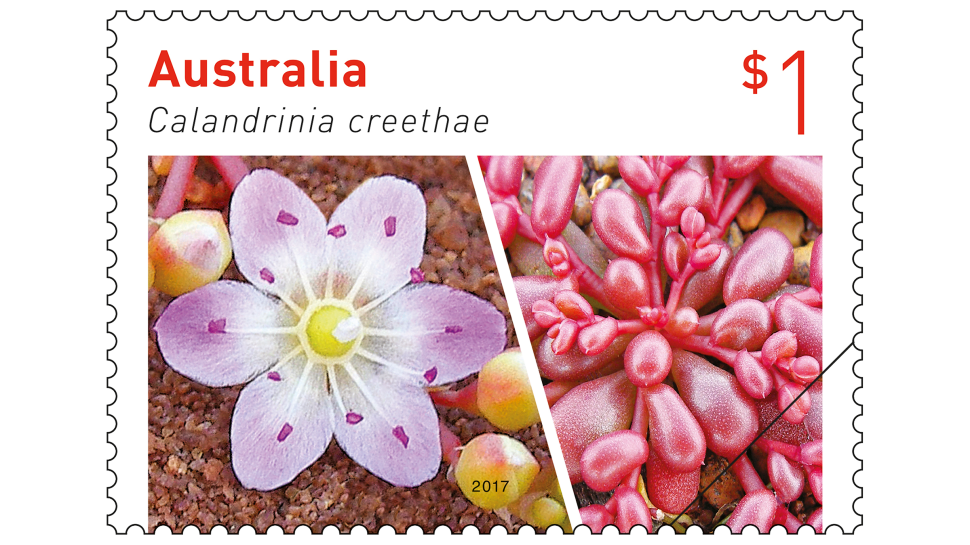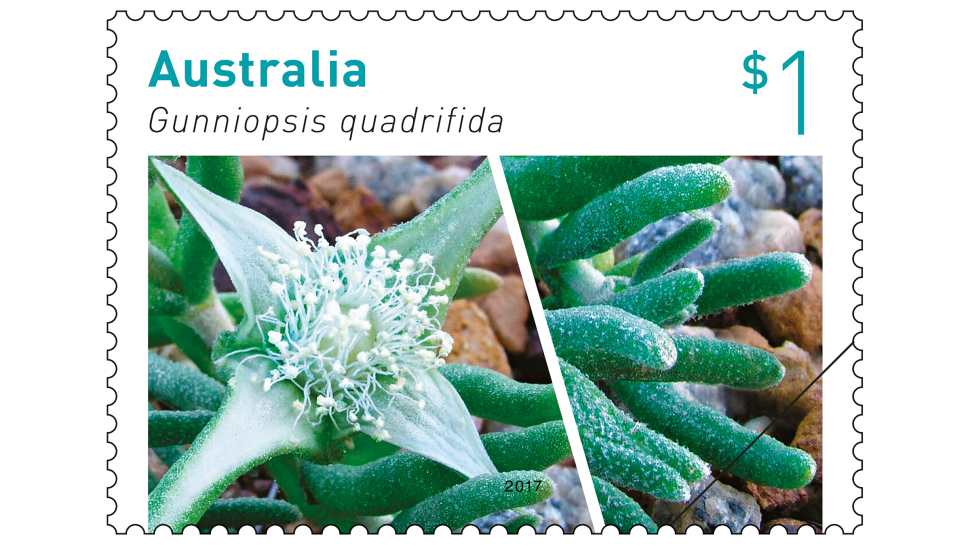When thinking about the term “succulent plant”, most Australians probably think about the exotic succulents and cacti they see in their local plant nursery, rather than the many wonderful Australian native varieties. Yet Australia is home to around 400 or so succulent species, located through most regions in Australia and in every state.
Succulents can be found in coastal, inland, temperate, subtropical and tropical environments. While many are groundcovers or low-growing, succulents also include orchids, hoyas, shrubs and even the boab. While species occur in a range of soils, some succulent plants are epiphytes (plants that grows on another plant) and lithophytes (plants that grow in or on rocks).
To showcase some these amazing ‘water-storers’, we are releasing the Australian Succulents stamp issue on 20 June 2017. The stamps, designed by Janet Boschen, feature four endemic Australian succulent plant species.
The photographs used in the stamp designs and many of the associated products are from the collection of Attila and Michele Kapitany. In fact, Attila provided extensive expert advice and assistance throughout the development of the stamp issue, right from the beginning of the process. His passion for cacti and succulents is well known, and he has dedicated more than 35 years of his professional life researching, growing and promoting Australian succulent plants to gardeners and the general public, especially the lesser known varieties.
Attila has toured the Australian and international speaking circuits, and he features on television and radio. Attila is immediate past president of the Cactus and Succulent Society of Australia, holding this position for 10 years. He is also a member of the Horticultural Media in Australia, writing regularly in magazines, journals and newspapers about the wonders of succulents. Attila has co-written seven books with Rudolf Schulz about succulents, with his eighth book a solo effort on Australian native species, as well as a more recent series of eight booklets on xerophytic Australian plants. Attila’s life-long interest in succulents is also evidenced by the amazing, sprawling ‘succulent’ garden that he and Michele have created at their home in Melbourne.
We spoke to Attila about his fascination with succulent plants, including the four species featured on the stamps.
What is it about succulents that captures your interest?
“I find their shapes, colours and growth habits fascinating.”
What is it that makes a plant “succulent”?
“Succulent, Succulents, Succulence? The word ‘succulent’ is widely used as a noun e.g. ‘a succulent’, as well as an adjective, e.g. ‘a succulent plant’. Botanists use the more accurate term ‘a succulent plant’ to describe plants having succulence. ‘Succulent plants’, often from arid and seasonally dry regions, have adapted to survive dry periods by having water storage tissue (succulence) in their leaves, stems, trunks or roots. After many months without rain a succulent plant such as common pigface will shrink considerably; then after flooding winter rains the plant rehydrates to be plump and highly succulent again.”
Are Australian succulent plants particularly distinctive, as compared to others found elsewhere?
“Worldwide succulent plants have no great distinction from continent to continent, but any Australian plant that has a relatively high level of water storage, in the form of succulence, become more distinct after floods. Australia mostly has small ephemeral species through much of the arid and semi-arid zones.”
What are some interesting facts about Australian native succulents that the general public may not be aware of?
“Most Australians are aware of common succulent plants in nurseries, markets and on grandmother’s front porch. This is a range of some of the world’s most garden-hardy types. One to two hundred species at best. The public are less aware that there are more than 12,000 recorded species of succulent plants worldwide; and Australia has at least 400 succulent species. Surprisingly more and more exotic species are being imported and grown here in Australia, yet little if any interest exists for trialling our native species. My mission statement is to change this and give Australian succulent plants a fair go!”
Can you tell us something of particular interest about each species featured on the stamp?
Portulaca cyclophylla
“This is a really weird-looking plant in habitat. Its foliage is often the same colour and textured appearance of the stony gravel in which it is found. Only the flowers gives their location away to botanists, and that location is central Western Australia. The flowers can be very large and eye-catching. They have an extended central stigma, which adds to their showiness.”
Tecticornia verrucosa
“This species grows to around 55 centimetres in height. It has an unusual formation, in that it has multi-segmented stems that function as leaves, even going through the process of photosynthesis. It is found in north, central and south-west central Western Australia; western Northern Territory; and north-western South Australia. This species produces an edible wheat-like seed that is still harvested to this day by Indigenous people.”
Calandrinia creethae
“Also called a ‘jellybean plant’, it is extremely colourful with bright greens, yellows, oranges and reds on display. It grows firstly as a rosette shape, then branches out to reach up to 80 centimetres in diameter. Calandrinias are certainly Australia’s most beautiful succulent plants, both in terms of colourful flowers, which can carpet the ground after desert rain, and the plant colour itself, which can be almost as colourful! Australian calandrinias are also the most widespread Australian succulent, with many perennial species and just as many annuals. Indigenous people favoured these plants as a food and water source in arid regions. Many animals and insects also rely heavily on calandrinias for survival e.g. emu chicks in arid regions rely totally on calandrinias for the first six weeks of their lives.”
Gunniopsis quadrifida
“This species is a perennial low-growing shrub that reaches around 50 centimetres in height and 1.5 metres in width. It is found in South-western Western Australia; southern Northern Territory; northern South Australia; south-western Queensland; and north-western New South Wales. This species has a most interesting flower with a fleshy green outer part. Here both the sepals and petals are fused as one.”
Your photographs appear on the stamps and you have a vast collection. Can you tell me more about it, including how and over what period of time you put the collection together?
“My wife Michele and I have a one-acre garden with more than 10,000 plants, many of which are succulent. We regularly introduce new types of mostly Australian species to trial them in our garden, for their garden-worthiness and to showcase them to the public on designated large open days. One special weekend we had over 1,100 visitors as part of the Open Garden Scheme. Exploring the deserts of Australia annually allows us to take hundreds of thousands of photographs. A government permit for seed collecting allowed us to trial very rare and unusual plants.”
Succulents would appear to offer some great options for gardeners. Can you elaborate?
“Succulents are at the forefront of water-wise, low-maintenance gardening around the world. They offer a wide range of form, colour and a great variety of application including the popular vertical and rooftop gardens.”
You played an advisory role to the researcher on this stamp issue. You must be very excited about the stamp release?
“I am very pleased that these plants are getting the recognition they deserve and will be introduced to the Australian public, many of whom may have no idea that we have such beautiful native succulents! It has been very rewarding assisting the team with this stamp issue, as it’s something I have been passionate about for many years.”
Additional images in this article are courtesy of Attila Kapitany. To learn more about Australian succulents, and Attila’s work, visit his website www.australiansucculents.com
The Australian Succulents stamp issue is available from 20 June 2017, online, at participating Post Offices and via mail order on 1800 331 794, while stocks last.
View the gallery of stamps and technical details for this issue.
This article was produced at the time of publication and will not be updated.






